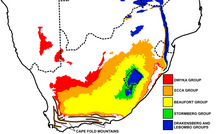Paraburnetia
Paraburnetia is an extinct genus of biarmosuchian therapsids from the Late Permian of South Africa. It is known for its species P. sneeubergensis and belongs to the family Burnetiidae.[1] Paraburnetia lived just before the Permian–Triassic mass extinction event.
The etymology of Paraburnetia sneeubergensis comes from para, meaning beside or near; Burnetia indicating the first named member of the clade; and sneeubergensis for the location the Sneeuberge mountains above where the specimen was found.[1]
P. sneeubergensis is known by its knobby skull,[1] which is a shared synapomorphy with B. mirabilis[2] and P. viatkensis[3] They are synapsids, from which, their clade of therapsids is derived from.[4] Descending from one of the first therapsids, biarmosuchus, Paraburnetia evolved prominent canine teeth, a long zygomatic process that extends under the orbit, and shorter phalanges with fewer joints that the lizard-like pelycosaurs.[4] They were small to medium in sized carnivores.[4] Burnetiamorphs distinguished themselves from the basal forms of Biarmosuchians by developing bumpy knobs on their skulls, specifically towards the posterior of the skull and on the nasal.[4]
Paraburnetia was first discovered by a team from the South African Museum working in the southern Karoo Basin during July 2000. The specimen had been separated into two large portions. The first of which was originally identified due to the 'knob' on the synapsid skull. The snout was found downstream in the lower Beau-fort Group. The fitting of these two portions created the most complete skull of a burnetiid therapsid to date.[5]
Previous burnetiids found were Burnetia mirabilis [2] from South Africa and Proburnetia viatkensis [6] from Russia. Historically, burnetiamorphs were difficult to place due to sharing characteristics with dinocephalians and gorgonopsians.[4] More recently, a series of taxa have been added to the group and its systematics have become better codified. Burnetiamorpha currently encompasses six genera: Bullacephalus, Burnetia, Lemurosaurus, Lobalopex, Niuksenitia, and Proburnetia[7][8]
Paraburnetia is diagnosed by the characteristics of a superior temporal bulbous vertical horn, an upper orbital boss with a defined apical crest, and an elongated palatine-pterygoid boss.[1] Paraburnetia and Proburnetia share features indicating a sister-taxon relationship, including the presence of a well-developed median nasal crest and tall superior orbital bosses [1]



